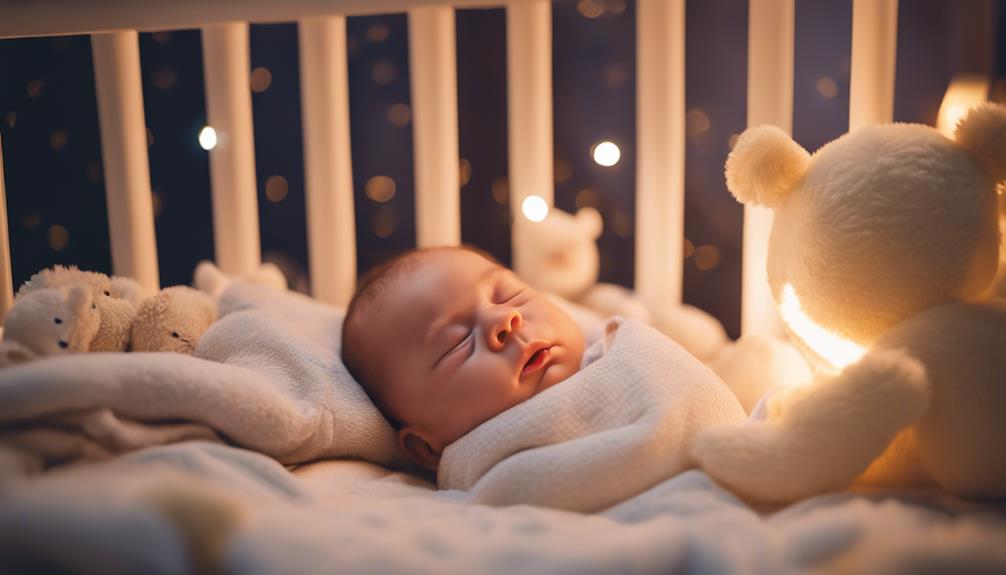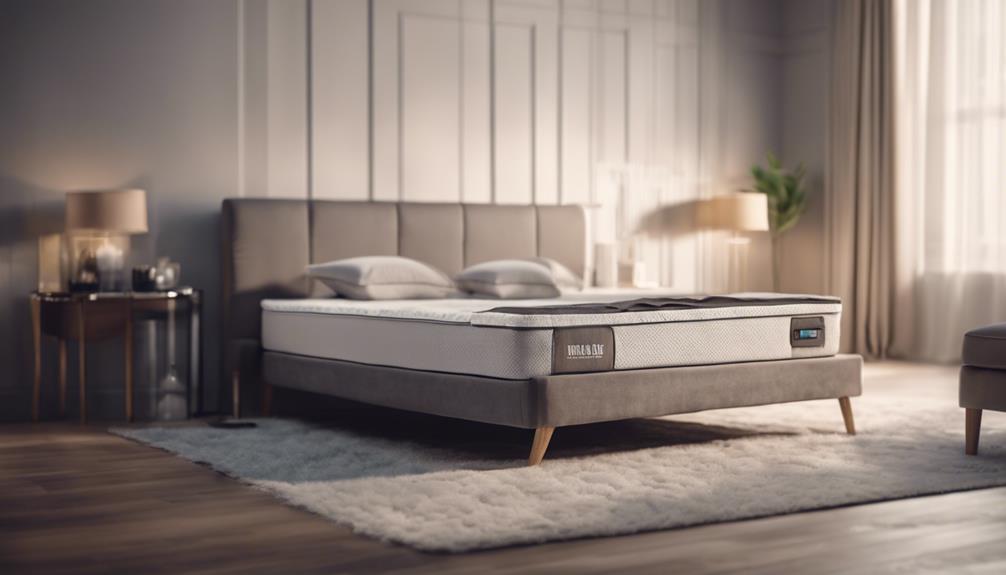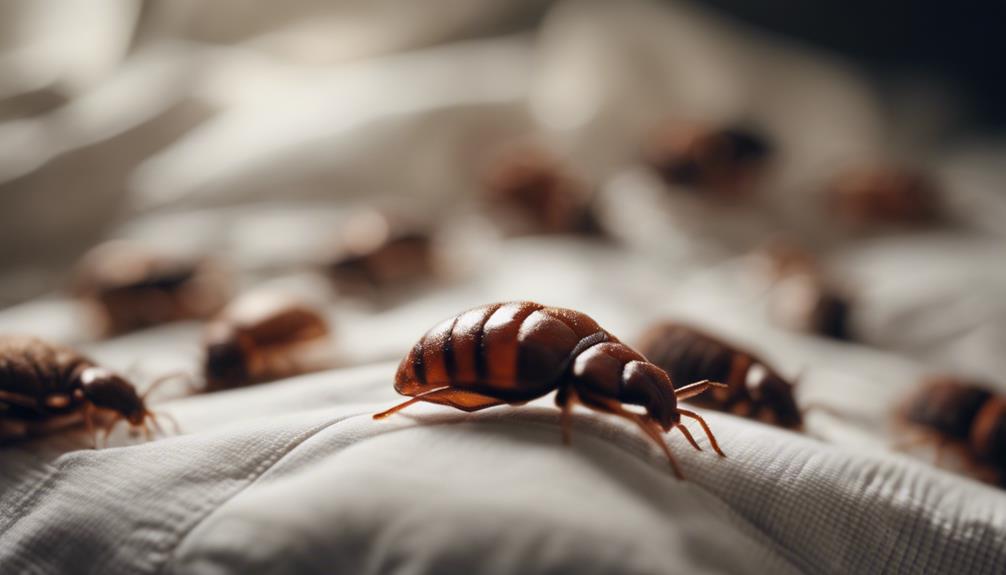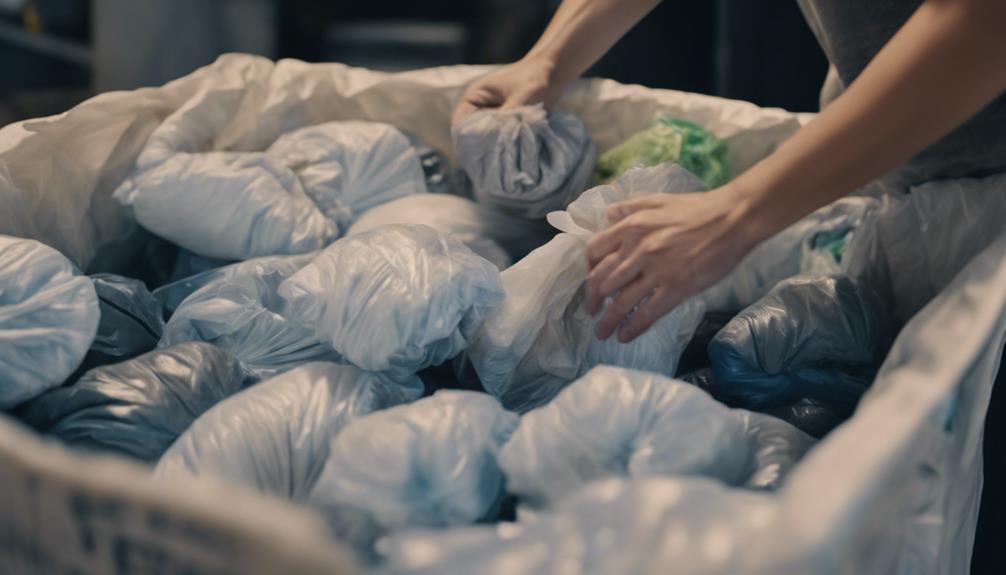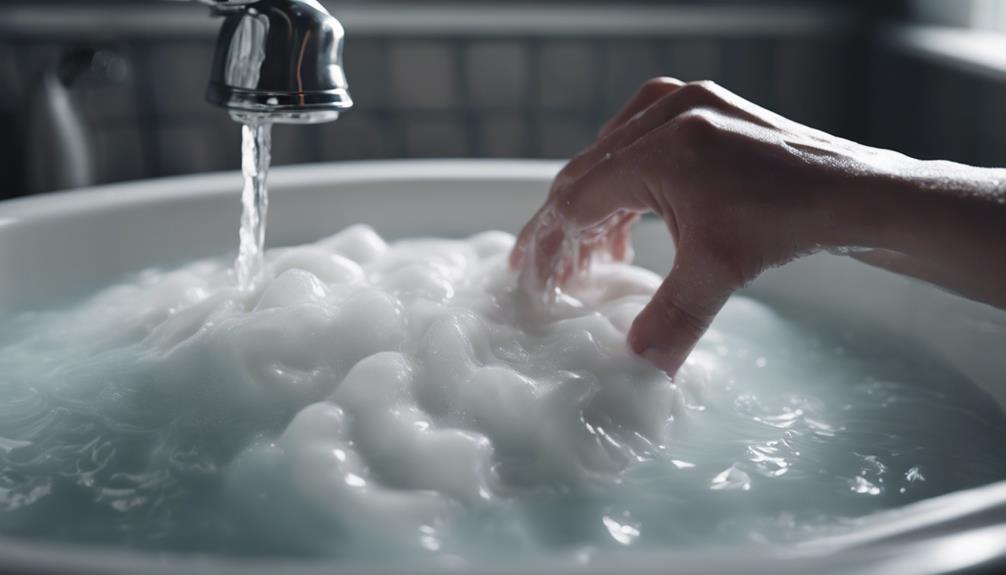We suggest waiting until your baby is approximately 6 months old before introducing a comforter to their sleep space. Always place the comforter near the baby during naps, but be sure to take it out of the crib once the baby falls asleep. To minimize the risk of suffocation, keep the comforter away from the baby’s nose and mouth. Choose a soft, lightweight comforter without small parts, ties, or batteries to create a safe sleeping environment. Remember, safety is crucial when it comes to your baby’s sleeping habits, so make informed decisions for peaceful nights.
Key Takeaways
- Wait until 6 months to introduce comforter for safe sleep.
- Supervise baby with comforter to prevent suffocation risks.
- Remove comforter from crib once baby sleeps.
- Choose a breathable and lightweight comforter for safety.
- Familiarize baby with comforter during supervised nap times.
Safety Concerns With Comforters

When thinking about the safety of babies sleeping with comforters, it's important to be aware of the potential risks of suffocation. Covering a baby's face with a comforter during sleep can pose serious dangers, as there's a risk of the baby rolling over onto the comforter and being unable to breathe properly.
Safety guidelines strongly recommend avoiding any objects near the baby's face while sleeping to guarantee a safe sleep environment. It's best for babies to sleep without items covering their faces to prevent any chances of suffocation.
Creating a sleep association with a comforter at such a young age can be unsafe, and it's paramount to prioritize the baby's safety above all else. To provide comfort without compromising safety, alternatives like using a breathable muslin square can be a safe option for babies during sleep.
Comforter Introduction for Babies
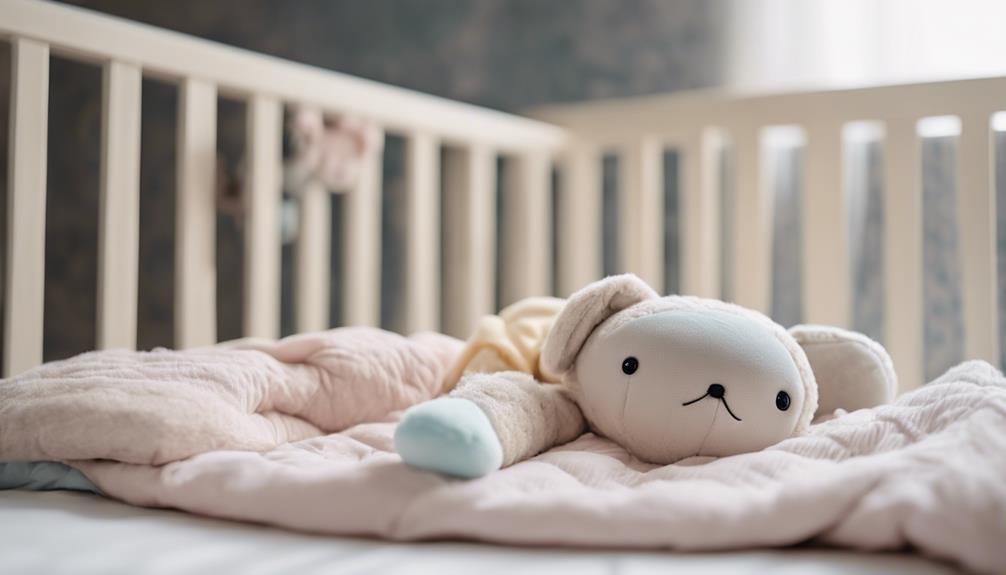
When introducing a comforter to babies, it's important to wait until around 6 months when they can grasp objects securely.
Place the comforter near the baby during naps and bedtime to help them get familiar with it.
Remember to remove the comforter from the cot once the baby falls asleep to reduce the risk of suffocation.
Safety of Comforters
Introducing a comforter to a baby's sleep routine can enhance their sense of security and comfort while following safety guidelines is essential. It is safe for babies to sleep with a comforter once they are at least 6 months old. Always make sure the comforter is free of small parts, ties, or batteries that could pose a choking hazard. Supervise the use of the comforter during sleep to prevent any risks of suffocation. Following safe sleep recommendations and guidelines when introducing a comforter to a baby's sleep environment is vital. Below is a table to highlight the key safety aspects to take into account when introducing a comforter to your baby's sleep routine:
| Safety Guidelines | Description |
|---|---|
| Age Requirement | Babies should be at least 6 months old before using a comforter. |
| Choking Hazard | Ensure the comforter is free of small parts, ties, or batteries that could be swallowed. |
| Supervision During Sleep | Always supervise the use of the comforter to prevent suffocation risks. |
| Follow Recommendations | Adhere to safe sleep guidelines when incorporating a comforter into the sleep routine. |
| Comfort & Security | A comforter can enhance emotional security and comfort for the baby during sleep. |
Comforter Material Choices
Choosing comforters made of breathable, washable fabric is essential for ensuring the safety and comfort of babies when introducing them to a sleep routine. When selecting a comforter material for your baby, consider the following:
- Breathable Fabrics: Opt for materials like cotton or muslin that allow air circulation, preventing overheating and ensuring your baby sleeps comfortably.
- Soft and Lightweight: Choose a soft and lightweight comforter that's gentle on your baby's delicate skin, providing a cozy and comforting feel without being too heavy.
- Easy to Wash: Prioritize washable fabrics that can withstand frequent cleaning to maintain a hygienic sleep environment for your little one.
Comforter Size for Cribs
To ensure a safe sleep environment for babies, it's vital to choose a comforter size suitable for cribs that prevents any risks of suffocation or obstructions.
When selecting a baby's comforter for the crib, it should be small enough to avoid covering their face while sleeping. The ideal size for a comforter in a crib is around 12 inches by 12 inches, ensuring safety for the infant.
Large comforters in a crib can pose a suffocation risk for babies during sleep, so opting for a small, lightweight comforter is essential. Parents must prioritize safety by choosing a comforter size that's appropriate for a crib setting, reducing the risk of accidents or breathing difficulties.
Comforter Alternatives for Infants

When considering comforter alternatives for infants, it's important to prioritize safe bedding options and create a conducive sleep environment.
Breathable muslin squares, lightweight sleep sacks, and washable loveys are all suitable choices for providing comfort without compromising safety.
Introducing these items gradually can help infants feel secure during sleep without the potential risks associated with traditional comforters.
Safe Bedding Options
As parents or caregivers of infants, selecting breathable muslin squares or lightweight blankets can offer a safe alternative to traditional comforters for their bedding needs. When it comes to guaranteeing a safe sleep environment for your baby, opting for these bedding options can help reduce the risk of suffocation and promote better sleep quality.
To provide comfort without compromising safety, consider the following:
- Breathable Materials: Choose bedding made from breathable fabrics like muslin to prevent overheating and promote air circulation around the baby.
- Securely Tucked In: Make sure that the bedding items are securely tucked in and can't cover the baby's face, reducing the risk of suffocation.
- Avoid Loose Bedding: Keep the sleep environment free of loose bedding to adhere to safe sleep guidelines and lower the risk of SIDS.
Sleep Environment Essentials
In choosing bedding for infants, we prioritize safety by opting for breathable muslin squares over comforters. While comfort items like blankets or stuffed toys can provide a sense of security for babies, they pose a suffocation risk during sleep.
For infants who may develop attachment to a comfort item, consider introducing intermediary objects during awake time to help with separation anxiety.
When it comes to creating a safe sleep environment, it's crucial to avoid potential hazards and follow guidelines from healthcare professionals. Opt for alternatives like sleep sacks or wearable blankets to guarantee a cozy yet safe sleeping space for your little one.
Monitoring Baby's Comfort With Comforter

To guarantee the baby's comfort and safety when using a comforter, it's essential to actively monitor their sleep position and any signs of restlessness or discomfort.
Here are three key points to think about when monitoring your baby's comfort with a comforter:
- Observe Sleep Position: Regularly check on your baby to make sure the comforter isn't covering their face, which could pose a suffocation risk. Adjust the comforter as needed to maintain a safe sleep environment.
- Monitor Signs of Discomfort: Pay attention to any cues of restlessness or discomfort your baby may exhibit while using a comforter. If your baby seems uneasy, consider removing the comforter or adjusting their sleeping position.
- Watch Breathing and Movements: Keep an eye on your baby's breathing patterns and movements while they sleep with a comforter. Changes in breathing or unusual movements could indicate that the comforter is affecting their comfort level.
Gradual Transition to Comforter Use
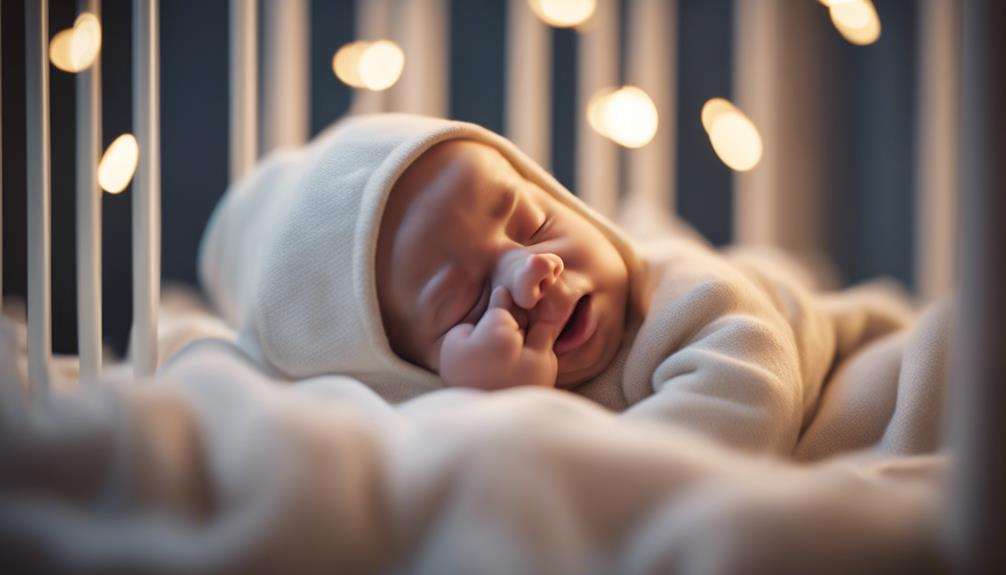
We eased our baby into sleeping with a comforter by introducing it gradually during supervised nap times. Introducing a comforter slowly can help them cope with this new addition to their sleep environment. By starting with short periods of supervised naps, babies can begin to associate the comforter with comfort and security. This gradual approach allows them to develop skills to help them feel safe and secure when the comforter is present during sleep.
During these supervised nap times, we observed our baby closely to monitor their reaction to the comforter. This helped us gauge if they were ready for this change and if the comforter was positively impacting their sleep routine. It's essential to make sure that the comforter is lightweight, breathable, and free from any potential choking hazards to create a safe sleep environment for your baby.
Ensuring Safe Sleep Environment
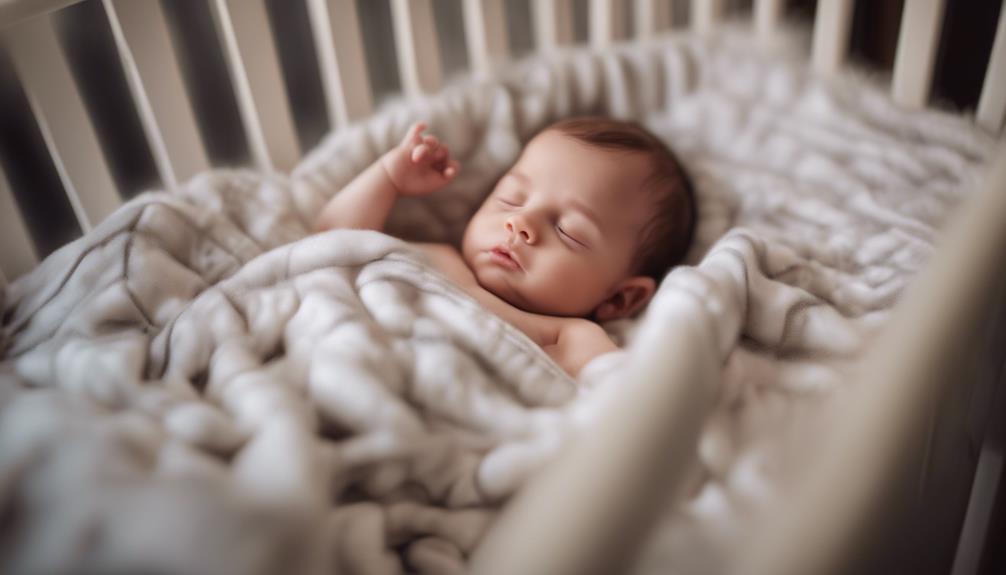
When ensuring a safe sleep environment for babies, it's crucial to adhere to recommended practices that prioritize their well-being. This includes using a firm mattress with a fitted sheet and avoiding loose bedding, pillows, or stuffed animals in the crib.
Maintaining a clear sleep space and placing the baby on their back can greatly reduce the risk of suffocation and create a secure sleeping environment.
Safe Sleep Practices
Creating a secure sleep environment for babies involves implementing safe sleep practices. To guarantee your baby sleeps safely with a comforter, follow these guidelines:
- Remove Comforter When Asleep: Take the comforter out of the cot once your baby is asleep to prevent any risks of suffocation.
- Keep Objects Away: Avoid placing any objects near your baby's face during sleep to maintain safe sleep practices.
- Choose Breathable Materials: Opt for breathable and lightweight comforters to reduce the chance of overheating.
Comforter Use Guidelines
In ensuring a safe sleep environment, it is essential to carefully select a lightweight and breathable comforter for your baby. When it's time to introduce a comforter, make sure it is safe for babies by following these guidelines:
| Guidelines | Details |
|---|---|
| Lightweight & Breathable | Choose a comforter that allows airflow and won't weigh down on the baby. |
| Age-Appropriate | Wait until the baby is at least 6 months old before introducing a comforter. |
| Safe Design | Select a comforter that is washable, free of small parts, ties, or batteries. |
| Supervised Use | Always supervise the baby when using a comforter to prevent any risks during sleep. |
Practical Tips for Comforter Management
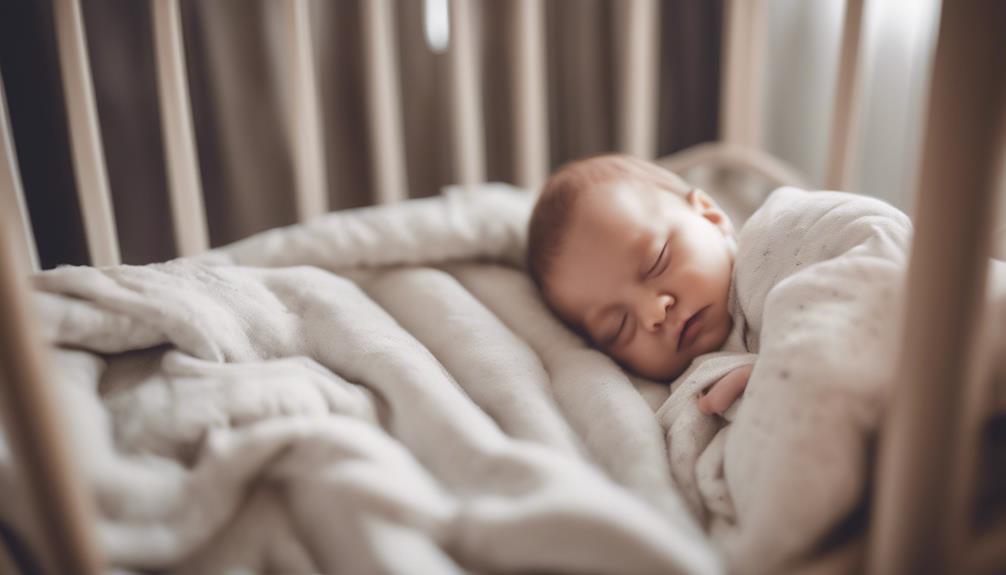
To effectively manage comforters for babies, position them near the baby early on to familiarize them with the comforter before they can hold it. This helps the baby associate the comforter with sleep and comfort.
When it comes to comforter management, there are a few practical tips to keep in mind:
- Wait for the Right Time: Wait until the baby is at least 6 months old before introducing a comforter during sleep. This reduces the risk of suffocation or other hazards.
- Remove During Sleep: Once the baby is asleep, it's crucial to remove the comforter from the cot. This precaution prevents any potential risks associated with loose bedding.
- Choose Wisely: Select a light, breathable, and safe comforter for your baby. Opting for materials that are gentle on the baby's skin and easy to clean promotes a comfortable and safe sleep environment.
Comforter Safety Guidelines

Ensuring comforters are kept away from a baby's nose and mouth is essential for reducing the risk of suffocation during sleep.
When considering comforter safety guidelines for baby sleep, it's vital to choose comforters that don't have small parts, ties, or batteries that could pose a choking hazard.
Safe sleep practices recommend keeping all objects away from a baby's face while they sleep to prevent any potential risks.
It's safer for babies to sleep without items covering their faces to maintain a secure sleep environment.
By following these guidelines, parents and caregivers can promote a safe sleep environment for babies, ensuring that comforters don't present any risk of suffocation or obstruction.
Prioritizing comforter safety is a key aspect of creating a conducive sleep space for infants, where their well-being and comfort are the top priorities.
Comforter Attachment and Security
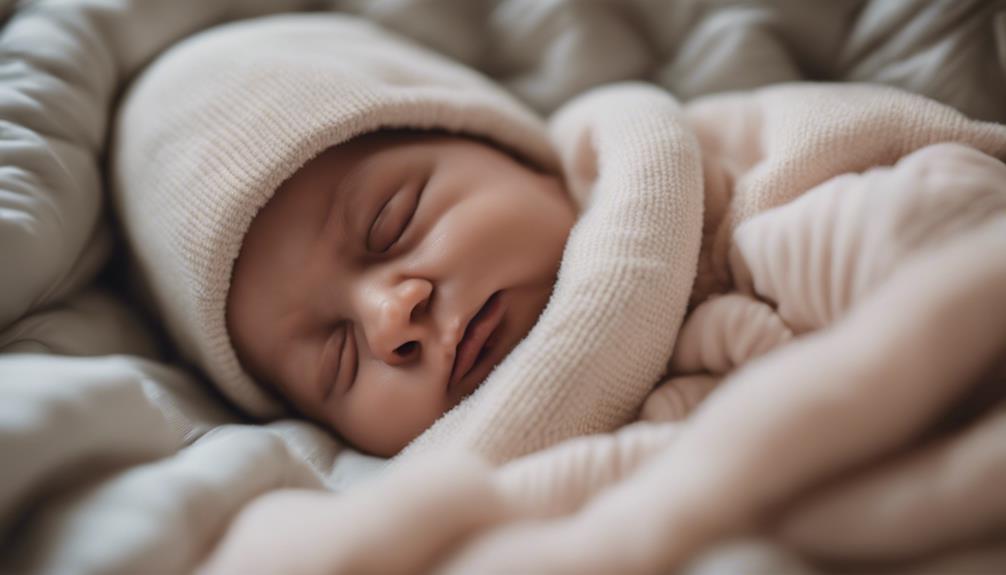
When discussing comforter attachment and security for babies, it's important to take into account their developmental needs and emotional well-being.
- Comforter Attachment:
Babies often form strong attachments to comforters, which can provide them with a sense of security and familiarity. This attachment is a vital part of their emotional development and can help them feel safe and comforted during times of stress or separation.
- Sense of Security:
Having a comforter can help babies develop a sense of security and self-soothing abilities, which are essential for healthy sleep habits. The presence of a familiar comforter can provide reassurance to babies, especially during bedtime or when they're in new or unfamiliar environments.
- Emotional Development:
The attachment to a comforter doesn't indicate insecurity in babies; instead, it can support their emotional development by teaching them to self-soothe and cope with different emotions. Introducing a safe and breathable comforter to babies in a supervised manner can contribute positively to their overall well-being.
Comforter Benefits and Risks
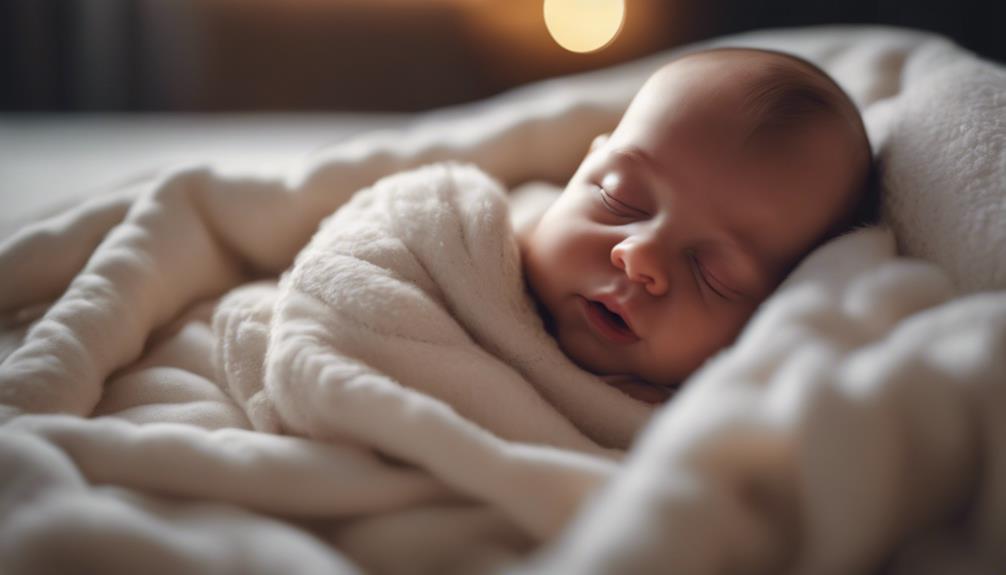
In considering the benefits and risks of using comforters for babies, it's important to prioritize their safety and well-being. A baby's comforter can provide emotional soothing and security during sleep, helping them self-soothe when used under supervision.
However, parents worry about the safety concerns associated with comforters, such as the risk of suffocation or obstruction while sleeping. To guarantee a baby's comforter is safe to use, it's vital to choose a light, breathable option that's washable and free of small parts that could pose a choking hazard.
Parents should always prioritize creating a safe sleep environment for their baby, especially when introducing a comforter. By being mindful of these factors, parents can help their baby benefit from the comfort and security a well-chosen comforter can provide while minimizing potential risks.
Frequently Asked Questions
At What Age Can a Baby Sleep With a Comforter?
Babies can typically start sleeping with a comforter around 7-9 months when seeking reassurance and comfort. It's advisable to wait until at least 6 months before introducing a comforter to their cot.
To minimize risks of suffocation, parents should remove the comforter once the baby is asleep. A light, breathable, and safe comforter can help babies develop self-soothing skills.
Monitoring readiness and ensuring safety are essential in determining when a baby can sleep with a comforter.
Can I Leave Baby With Comforter?
Absolutely, we can leave the baby with a comforter, ensuring safety measures are in place. Supervision during sleep is essential to avoid potential risks.
Opt for a breathable fabric without small parts or choking hazards. Comforters offer security and comfort, aiding in self-soothing and bedtime routines.
Can a Comforter Smother a Baby?
We must prioritize baby safety. A comforter near a baby's face can be dangerous, potentially leading to suffocation.
It's essential to keep all objects away from the baby's face during sleep to prevent any risk of smothering.
By ensuring a clear and open sleep environment for the baby, we can help reduce the chances of any accidents occurring.
When Can a Baby Sleep With a Comforter Lullaby Trust?
Let's remember, safety first! Guarantee the baby is at least 12 months old before introducing a comforter to their sleep environment.
Prioritizing safe sleep practices, like those recommended by the Lullaby Trust, can reduce the risk of Sudden Infant Death Syndrome.
Waiting until the baby is older minimizes potential hazards associated with introducing a comforter too early, promoting a secure and cozy sleep environment for your little one.
Conclusion
To sum up, when contemplating the use of comforters for babies, it's crucial to take into account safety guidelines and carefully monitor their usage. Gradually introducing a comforter and ensuring it's securely attached can help mitigate any potential risks.
By following practical tips and being mindful of both the advantages and drawbacks, parents can make well-informed decisions regarding whether their baby can sleep with a comforter. Remember, safety should always be the foremost concern when it comes to your little one's well-being.
